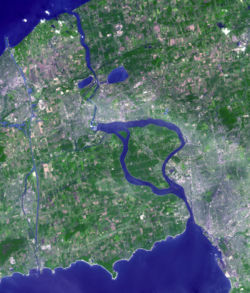This article relies largely or entirely on a single source .(January 2023) |
Niagara Frontier | |
|---|---|
 Niagara Frontier from space | |
 Location of the Niagara Frontier in New York. ██ Niagara Frontier ██ Rest of New York State | |
| Country | |
| State | |
| Largest City | |
The Niagara Frontier refers to the stretch of land in the United States that is south of Lake Ontario and north of Lake Erie, and extends westward to Cleveland, Ohio. The term dates to the War of 1812, when the northern border was in contention between the United States and British forces in Canada. It refers only to the land east of the Niagara River and north of Lake Erie within the United States. The western side of the Niagara River, on the Canada/Ontario side, is the Niagara Peninsula; it is considered part of the Golden Horseshoe.
Contents
The Niagara Frontier is part of the region known as Western New York State. The Niagara Frontier also forms the eastern part of the Great Lakes North Coast. Its southeastern boundary forms what is known as ski country, as it includes the northernmost area of the Appalachian Mountain foothills.
The National Weather Service office in Buffalo, New York defines the Niagara Frontier as the following:
- Erie County, New York north of US 20A – includes Buffalo, New York
- Niagara County, New York – includes Niagara Falls, New York
- Orleans County, New York
- Genesee County, New York – includes Batavia, New York
Other, less common, definitions may include the following areas:
- Erie County, NY south of US 20A (also known as the Buffalo Southtowns)
- Chautauqua County, New York (particularly the area that is part of the Lake Erie watershed, north and west of the Chautauqua Ridge. The southeastern part of the county, in the Conewango Creek watershed, is not part of the Niagara Frontier. It is considered part of the adjacent Southern Tier to the east)
- Erie County, Pennsylvania – includes Erie, Pennsylvania
- Ashtabula County, Ohio
- Lake County, Ohio
- Cuyahoga County, Ohio – includes Cleveland, Ohio